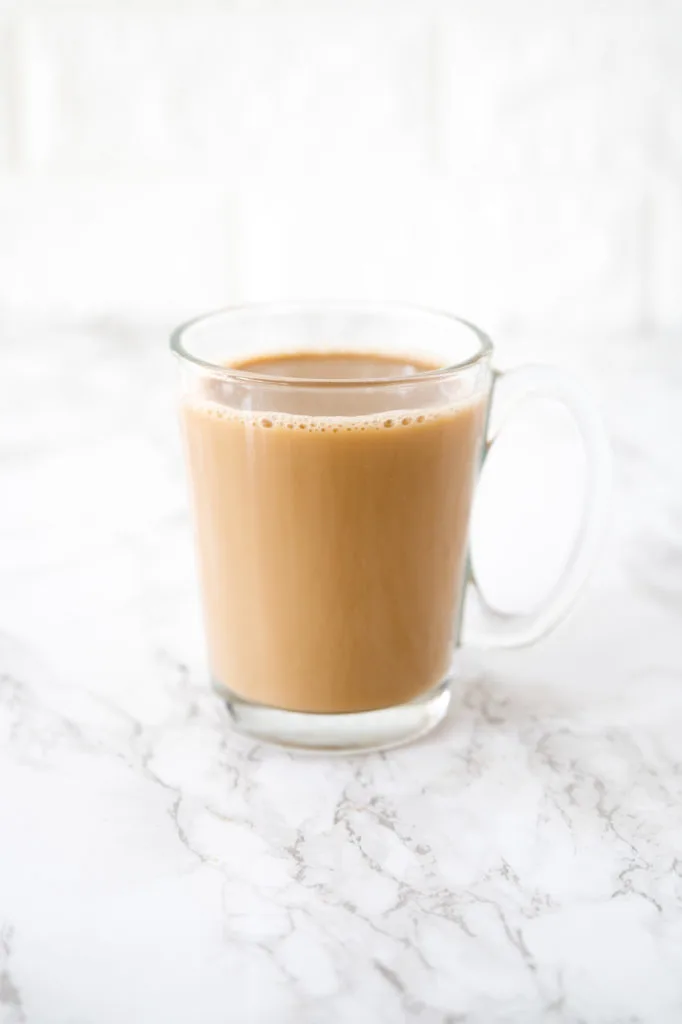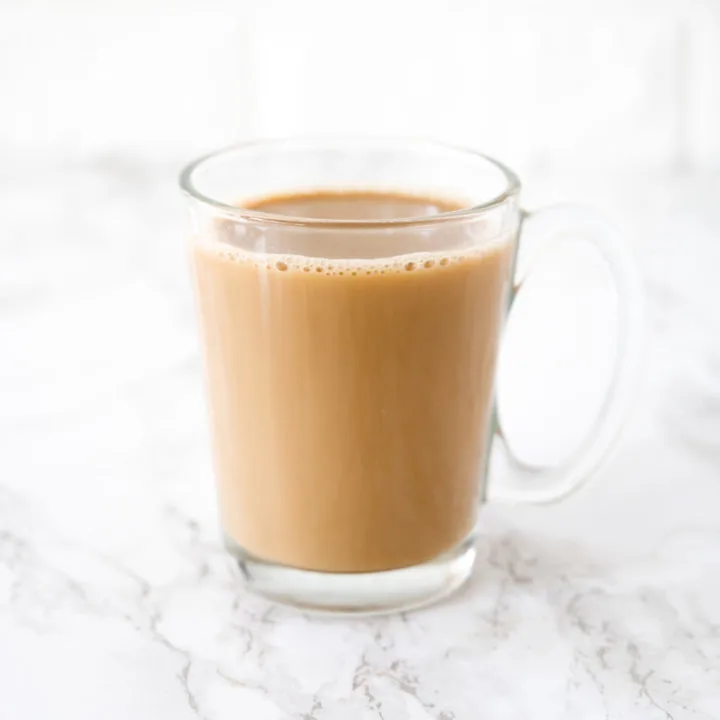This coffee with oat milk is dairy free, but you'd be hard pressed to tell! In fact, I'd argue it is even better than coffee made with real milk!

For so many, a cup of coffee is a necessity. For others, it is an essential part of their morning routine.
Some of my favorite memories is chatting with my mom over a cup of coffee in the morning. For me, there has never been a better way to start the day.
To be fully honest with you, I've never liked dairy free milks until I discovered really good oat milks.
I liked coconut milk, but that was more of a flavored creamer and doesn't work in all recipes.
Almond milk has always tasted like almond flavored water to me, and I didn't love it as a replacement for milk in almost anything.
Then, I discovered oat milk, and luckily, I tried the really good brands first. Otherwise, I would have given up on it too.
My first time trying oat milk, I tried it in coffee and hot chocolate with oat milk, and I was seriously impressed.
I quickly realized that depending on the oat milk you use, coffee with oat milk can be even creamier and more delicious than coffee with dairy milk.
If you enjoy this recipe, you may also enjoy my cold brew coffee with oat milk and my iced coffee with oat milk.
Choosing your Brand
I have tried a handful of oat milk brands and I can tell you, not all oat milks are created equal.
Some brands taste like oats and have the consistency of water. Other brands have a milder taste and are slightly reminiscent of milk. Oatly and Alpro are my two go-to brands.
When I visit New York, I really like Oatly, which I find to taste like regular milk and to be a little extra creamy. I'd assume this is true in Canada too.
In Israel, I only use the barista version of Oatly, which is still more watery than the regular Oatly in the States. I expect it is the same in Europe because that is where it is imported from.
For Israel and Europe, I find the Alpro oat milk indistinguishable from the Oatly Barista. However, the Alpro "Not Milk" oat milk I find to be almost identical to milk but a little sweeter - which I like.
Sugar
The primary role of sugar is to be a sweetener. However, sugar also contributes to the tenderness and moistness of the baked good by absorbing and retaining moisture and helps create the golden brown color when baking as it caramelizes.
Recipes with more sugar often result in softer, moister textures. However, I learned the hard way that too much sugar leads to a sticky mess.
When it's heated, sugar caramelizes, resulting in a rich, complex flavor and a brown color. This adds both flavor and color to baked goods and is also the process in which caramel sauce, dulce de leche, caramel candies, and regular candies are made.
When used in recipes containing yeast, the sugar is eaten by the yeast, producing carbon dioxide and causing the dough to rise.
Sugar also acts as a preservative in jams, jellies, and fruit preserves by reducing water activity and preventing microbial growth.
There are many different types of sugar, including white sugar, brown sugar, vanilla sugar, powdered sugar, turbinado sugar, and demerara sugar.
When a recipe calls for “sugar” without specifying anything else, it's referring to regular white sugar.
White Sugar
White sugar (sometimes called granulated sugar, table sugar, or white granulated sugar) is made of either beet sugar or cane sugar, which has undergone a refining process.
It is the easiest to find and most commonly used.
Brown Sugar
Brown sugar is white sugar with molasses added to it.
It is commonly used in chocolate chip cookie recipes, and it’s rare for a recipe that calls for brown sugar not to also call for white sugar as well.
When a recipe calls for “brown sugar” but doesn’t specify what type (light or dark), it is referring to light brown sugar.
In my recipes, you can use whatever type of brown sugar you have on hand, whether it is dark brown sugar, light brown sugar, or demerara sugar - which is very common in Israel.
Just keep in mind that the flavor and color will be slightly different, depending on what you choose to use.
Turbinado Sugar
Turbinado sugar is better known as "raw sugar." But, despite this name, the sugar is not really “raw.”
Instead, it's partially refined sugar that retains some of the original molasses.
The term "raw sugar" may also give off the impression that it is somehow healthier.
In reality, turbinado sugar is nutritionally similar to white sugar.
Demerara Sugar
Demerara sugar is very popular in Israel and is especially delicious in tea, but is also used for baking.
Unlike white sugar, demerara sugar undergoes minimal processing and retains some vitamins and minerals.
However, it is still not much healthier than white sugar.
Vanilla Sugar
Vanilla sugar is not very common in the States. However, it is common in Israel and parts of Europe.
This is sugar that sat for an extended period of time with vanilla beans, giving it a vanilla flavor.
Caster Sugar
This type of sugar is common in the United Kingdom.
It has a grain finer than white (granulated) sugar and larger than powdered sugar.
Caster sugar is often called for in recipes for delicate baked goods like meringues, souffles, and sponge cakes.
You can use a 1:1 conversion rate between caster sugar and white (granulated) sugar.
Powdered sugar
Powdered sugar, sometimes known as confectioners’ sugar, is a sugar with a powdered texture.
This sugar is rarely used for baking. Instead, it is used for dusting desserts and making frosting, icing, and glazes.
In some countries, you can also find powdered vanilla sugar.
It is made the exact same way regular vanilla sugar is made. However, the sugar used is powdered instead of granulated.
Vanilla Extract vs Vanilla sugar
In my recipes, I don’t specify what kind of vanilla to use.
The reason for this is that in the States, vanilla extract is exclusively used.
Meanwhile in Israel, along with many European countries, vanilla sugar is common.
In most, if not all recipes, both vanilla extract and vanilla sugar can be used.
In recipes where vanilla sugar can be used instead of extract, you can replace them 1:1.
Replacing Sugar with Honey
If you’d prefer to use honey instead of sugar, you can do so with pretty good results.
Honey can be two or even three times as sweet depending on the honey, so for every 1 cup of sugar, you can use ½ to ⅔ cup honey.
Since honey adds liquid, you need to remove some to balance it out. For every cup of honey, remove a ¼ cup of liquid.
Also, it burns faster than granulated sugar, so you want to lower the baking temperature by 25 F. In addition, check it early and often to avoid burning or overbaking.
How to Store Sugar
Sugar should be stored in an airtight container to prevent clumping and moisture absorption, and kept in a cool, dry place.
How can I drink coffee without dairy?
Milk in coffee can be replaced with a dairy free milk or left out entirely. This recipe uses oat milk.
Do I have to use instant coffee for this recipe?
Not at all! I put instant coffee because it is what most people have on hand. However, you can use coffee made any way you like.
Coffee with Oat Milk

Coffee with oat milk is the perfect way to start your dairy free day!
Ingredients
- 1 teaspoon instant coffee*
- 1 - 2 teaspoons sugar
- 1 cup water
- Mild flavored full fat oat milk
Instructions
- Place instant coffee and sugar in a cup.
- Bring water to a boil and fill the cup.
- Add a splash or two of oat milk.
Notes
*If you prefer to use another kind of coffee, replace the instant coffee and cup of water in this recipe with 1 cup of black coffee made any way you like it.
Nutrition Information:
Yield:
1Serving Size:
1Amount Per Serving: Calories: 41Total Fat: 0gSaturated Fat: 0gTrans Fat: 0gUnsaturated Fat: 0gCholesterol: 0mgSodium: 10mgCarbohydrates: 10gFiber: 0gSugar: 10gProtein: 0g